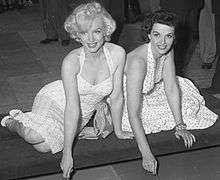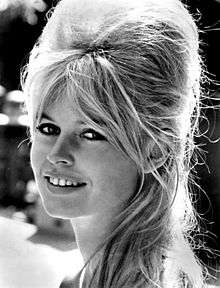Bombshell (sex symbol)


The term bombshell is a forerunner to the term "sex symbol" and originally used to describe popular female sex icons. In modern usage, bombshell refers to a very attractive woman.[1][2] The Online Etymology Dictionary by Douglas Harper attests the usage of the term in this meaning since 1942, and in the meaning of "shattering or devastating thing or event" since 1860.[3]
History
The first woman to be known as a bombshell was Jean Harlow, who was nicknamed the "blonde bombshell" for her 1931 film Platinum Blonde.[4][5][6][7] Two years later she starred in the Metro-Goldwyn-Mayer film Bombshell.[4] One of the blurbs on posters was "Lovely, luscious, exotic Jean Harlow as the Blonde Bombshell of filmdom."[8]
The epithet rose sharply in popularity after the death of Marilyn Monroe in 1962, and declined in popularity in late 1960s due to emerging ideological conflicts.[9]
Hollywood soon took up the blonde bombshell, and then, during the late 1940s through the early 1960s, brunette, exotic, and ethnic versions (e.g., Jane Russell, Dorothy Dandridge, and Sophia Loren) were also cultivated as complements to, or as satellites of, the blonde bombshell.[10] Some of the film stars, largely of 1940s–1960s, referred to as bombshells include Marilyn Monroe, Rita Hayworth, Diana Dors, Jayne Mansfield, Mamie Van Doren, Jane Russell, Ava Gardner, Carroll Baker, Brigitte Bardot, Kim Novak, Sophia Loren, Elizabeth Taylor, Ann-Margret, Veronica Lake, Raquel Welch, and Ursula Andress.[9][11]
Stereotype
Bombshells are identified with hypersexuality, their curves, including hourglass figures and large breasts, sex appeal, larger than life personas,[9] as well as stereotypes associated with blonde women and supermodels.[9][10][12]
See also
References
- ↑ Merriam-Webster Dictionary
- ↑ Oxford Dictionary
- ↑ "Bombshell". Dictionary.reference.com. Retrieved 2012-08-20.
- 1 2 Jordan, Jessica Hope (2009), The Sex Goddess in American Film, 1930–1965: Jean Harlow, Mae West, Lana Turner, and Jayne Mansfield, Cambria Press, p. 213, ISBN 1-60497-663-2
- ↑ Bombshell: The Life and Death of Jean Harlow by David Stenn, page 151, 162
- ↑ The Guide to United States Popular Culture, 2001, ISBN 0-87972-821-3, p. 922
- ↑ Grant David McCracken."Marilyn Monroe, the Inventor of Blondeness", Culture And Consumption II: Markets, Meaning, And Brand Management, page 93, Indiana University Press, 2005, ISBN 978-0-253-34566-0
- ↑ Richard HAvers, Richard Evans, Marilyn, 2010, ISBN 1-84912-026-9, p. 16.
- 1 2 3 4 Stephanie Ann Smith (1 January 2006). Household words: bloomers, sucker, bombshell, scab, nigger, cyber. U of Minnesota Press. p. 74. ISBN 978-0-8166-4553-4. Retrieved 13 September 2011.
- 1 2 Katie King and Debra Walker King, Body Politics and the Fictional Double, page 157, Indiana University Press, 2000, ISBN 978-0-253-10832-6
- ↑ Harry M. Benshoff and Sean Griffin, America on Film: Representing Race, Class, Gender, and Sexuality at the Movies, page 344, John Wiley & Sons, 2011, ISBN 978-1-4443-5759-2
- ↑ Afshan Jafar and Erynn Masi de Casanova (edited), Global Beauty, Local Bodies, page 73, Palgrave Macmillan, 2013, ISBN 9781137365347